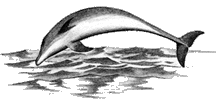Communication in bottlenose dolphins appears to be extensive and complex. A dolphin maintains an intricate social network that includes a few close associates (such as mothers and calves or pair-bonded males), plus more casual relationships with others that come and go within a larger group. Dolphins hunt together to find food. Pods of dolphins coordinate their movements to herd prey, then take turns swimming into the middle of the assembled fish to eat. There is still much to learn about how dolphins communicate.
Since water transmits sound so much better than air, dolphins rely on sending and receiving in-water sounds for communication more than any other mode.
Each dolphin seems to develop a distinctive high-pitched whistle which scientists call a signature whistle and which serves as a means of individual identification.
It may let the rest of the pod know who is around, where they are, and perhaps, something about their mental state. Dolphins in distress sometimes emit their signature whistles very loudly. Whistles may serve to establish or maintain vocal or physical contact between dolphins. Dolphins often respond to another dolphin whistling by whistling themselves or moving toward the whistler. If they become separated a young calf and its mother whistle frequently until reunited. Dolphins also whistle when separated from other group members.
Dolphins are capable of imitating certain sounds very accurately and often learn other dolphins' whistles. One reason for imitating another dolphin's whistle may be to make contact with that dolphin and get its attention within a large group. Dolphins may use other sounds besides whistles to communicate. Courtship behavior can yield pulsed yelps. When under duress, dolphins emit pulsed squeaks. Aggressive confrontation can produce buzzing click-trains. When a dolphin in the wild slaps its tail on the water, it is usually a sign of annoyance or a danger warning to other dolphins. Dolphin "friends" may swim along face to face touching flippers. They can also be seen swimming, twisting, and turning in perfect synchronization.

Below is a list of dolphin behaviors possibly used for visual communication.
Eye white display: Rolling eyes, showing the whites.
Flex: ;Bend head and tail dorsally.
Head wag: ;Rapid, side to side shaking of the head.
Play dead: Roll over submissively in the vicinity of another dolphin.
Snit: Sharp, sideways head jerk with closed or open jaws; may be accompanied by a sound *.
(* May indicate agitation or agressive behaviour)
Researchers take great care to keep dolphins from seeing any human who may know the right answer to a research question.

Butt: Hit with melon or snout.*
Hold hands: 	Swim with pectoral fins overlapping.
Mouth: ;Touch another animal with open mouth.
Nuzzle: Touch or rub another animal with closed mouth.
Pectoral Pat: Tap or stroke with pectoral fins.
Push: Forcefully press against another animal with head or rostrum.*
Ram: Hit another animal full force, head-on.*
Rub: Two animals touch body parts, moving against each other with friction.
Stranding on chest: One animal inverted, lifting another out of water, putting recipient between the flippers (often between mother and calf)
Stranding on rostrum: One animal lifting another out of the water, carrying recipient on the rostrum (often between mother and calf).
Tail kick: ;Strike with tail.*
Tooth rake: ;Draw teeth across the body of another animal.*
(*May indicate agitation or aggressive behavior.)